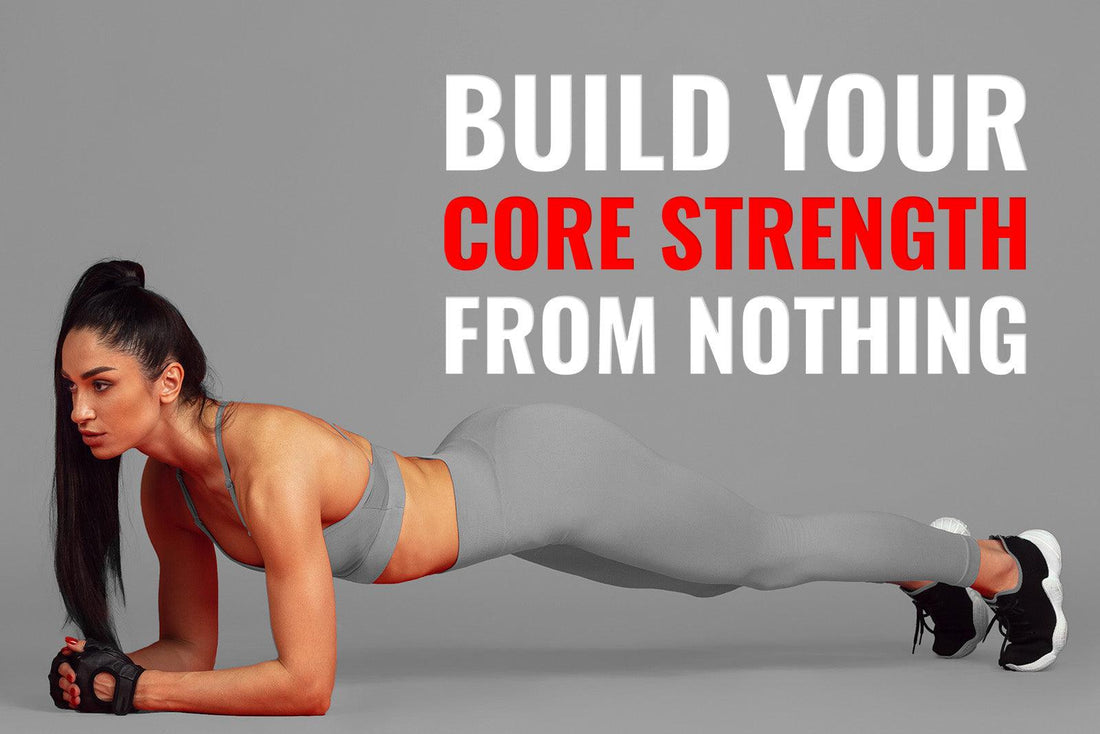Starting your fitness journey feels intimidating, and we know it! All of us have had days when the dreams were big, motivation was high, but the motivation to do the work was low.
There are a lot of benefits of core strength. Whether you want to build a six pack or you want to build up your core strength – we are here to help you through each and every step!
SUPMOGO is committed to helping you on your fitness journey by educating you, helping you build core strengthening, achieve faster recovery, and aid in rehabilitation.
Now let's talk about how to build core strength from nothing!
Here's what you'll learn in this article.
- What Is The Core?
- Core Muscles | How To Strengthen Core Muscles?
- Major Muscles
- Minor Muscles
- Why Is Core Strength Important?
- Helps Perform Everyday Tasks
- Promotes Balance and Stabilization
- Keeps Strong Posture
- Lowers the Incidence of Back-Related Disorders
- Aids in High-Intensity Workouts
- Benefits Runners and Athletes
- Promotes Healthy Aging
- How to Start Building Core Strength?
- How Long Does It Take To Strengthen The Core?
- Can You Train The Core Every Day?
- 15 Beginner Exercises for Strong Core and Abs
- Best Exercises for Core Strength According to the Specific Muscles
- Tools to Help in Building Core Strength | SUPMOGO Recovery Flex System Belt
What Is The Core?
You can think of your core as the center of your body. It is not the same as the six packs that you always crave. In fact, it is involved in some of your body's most important functional movements. The core muscles makeup your lower back, pelvis, hips, and abdomen.
According to Harvard Health, your core muscles are the muscles around your torso that help move, support, and stabilize your pelvis, trunk, and spinal region, thereby contributing to your legs and upper body movements.
It supports your spine, protects against excessive force, aids in breathing, stabilizes your posture, ensures joint stability, and controls the movement of the upper and lower bodies.
Research shows that strengthening the core facilitates recovery from injury and relieves chronic back pain. [1]
Core Muscles | How To Strengthen Core Muscles?
Your entire core is made-up of the following muscles:
Major Muscles:
- Transverse Abdominis
- Multifidus
- Internal Obliques
- External Obliques
- Erector Spinae
- Diaphragm
- Pelvic Floor Muscles
- Abs
- Rectus Abdominis
Minor Muscles:
- Latissimus Dorsi
- Trapezius
- Glutes
The simple answer to how to build core strength is to start working out today. There is no quick-fix formula that will work in strengthening your core. Depending on your body type, you need to dedicate at least 4-8 weeks or more.
Learn about the muscle-mind connection from Dr. Sam Rassoul and start your core strengthening exercises. There's a surprise at the end that we can't wait to share with you. Keep reading to find out for yourself!
Why Is Core Strength Important?
The importance of core strength can be attributed to a number of factors. We will dive deeper into these reasons, but remember that your core allows you to perform everyday tasks like a breeze. Once you start encountering core-related problems, you will experience a decline in health and productivity.
That's why core strength is so important.
1. Helps Perform Everyday Tasks
It helps perform everyday tasks, from carrying heavy groceries to lifting the kids or pets and doing home chores.
2. Promotes Balance and Stabilization

It aids in balance and stabilization while picking things up from the ground, sitting, or bending forward.
3. Keeps Strong Posture
A strong core helps keep a good posture while working in the office or even playing sports.
4. Lowers The Incidence Of Back-Related Disorders
Reduces back pain as well as other back related disorders for example, muscle strain, scoliosis, sciatica, osteoporosis, or herniated disc.
5. Aids in High-Intensity Workouts
Helps you perform high-intensity work such as exercises, playing sports, or doing housework.
6. Benefits Runners and Athletes
It also helps runners and athletes increase their work performance, reduce fatigue and chances of injuries, and improves endurance. Having a weak core while being an athlete or fitness enthusiast can be extremely dangerous. A weak core makes you prone to injuries, can cause lower back pain, and sabotages your posture increasing the chances of various back related problems. [2]
7. Promotes Healthy Aging

Aids with healthy aging without the struggles of back pain, disc herniation, or sciatica pain. According to research, core strengthening among older adults also improves balance and stability. [3]
How to Start Building Core Strength?
As mentioned earlier, the simple answer is to start strengthening exercises and work out regularly. Consistency is the key to achieving success, and the same goes here. The more consistent you are, the better your chances are of achieving faster results.
Start with low-intensity exercises to help your body get used to the new movements. Keep your mind open to the muscle-mind connection, and consciously perform each movement while engaging and working your core.
Taking breaks during your sessions and a day or two during the week is essential. If you over exercise the muscles, you have a higher chance of injury and hence require muscle rehabilitation.
How Long Does It Take To Strengthen The Core?
It takes about 4-8 weeks of consistent effort in strength training your core and build your abs. Researchers found that a core training program of 8 weeks improved static balance, core endurance, and running economy in male college athletes. [4]
It is important to remember that core strengthening and developing abs are directly related to what you eat and how you live. Get your energy for your workout by eating healthy and taking your carbs as a pre-workout meal. Eating a post-workout meal that's high in protein will help you replenish your protein stores. Balance these meals with all three macros and healthy fats. These three with help you get better and give you faster results!
Indulging in dangerous behaviors like overexercising, not taking breaks, or overconsumption of proteins can be a threat to your health. So always strive for optimal results with the best eating and training habits.
A study on muscle strength and physical performance concluded that dietary patterns high in red meat, potato, gravy, and butter had an adverse effect on muscle strength and physical performance. This proves that an unhealthy diet high in saturated and Trans fat can sabotage your muscle strength. [5]
Can You Train The Core Everyday?
No, instead of concentrating on your core everyday, you can alternate between low-intensity exercises to promote active muscle recovery. Training your core everyday increases your risk of muscle injury.
You can also wear the SUPMOGO Recovery Flex System Belt while working your core. This fitness wearable belt strengthens your core while you comfortably sit on your couch sipping your coffee. The SUPMOGO Smart Control App gives you complete control over how long you want the contraction. As you become more adept at core strengthening, you can increase the intensity and the duration through the app.
15 Beginner Exercises for Strong Core and Abs
Below are some beginner-friendly exercises to help you begin your core strengthening journey!
- Planks
- Abdominal Crunches
- Bridges
- Pelvic Bowls
- Pelvic Tilts
- Hip Dips
- Leg Lifts
- Supine Toe Touches
- V-Sit-Ups
- Cat-Cow Pose
- Dead Bug
- Bird Dog Crunches
- Leg Raisers
- Bicycles
- Squats
Start with low-impact exercises with fewer sets and longer breaks. When your body becomes accustomed to the movements, you can increase the intensity and the set amount while shortening the break durations.
Best Exercises for Core Strength According to the Specific Muscles
Once you've gained some core strength, it's time to focus on specific muscles. You don't have to perform all the exercises mentioned below, but knowing which exercise can help for which muscle may benefit you when you are planning to target any specific muscle group. Paired with each exercise is a link to YouTube tutorials so you can get started immediately!
Major Muscles:
- Transverse Abdominis – Hollow Body Hold, Dead Bug, Planks, and Bird Dog
- Multifidus – Deadlifts and Squats
- Internal Obliques – Side Plank, Standing Trunk Rotation, Russian Twist, Mountain Climbers, and Dead Bug
- External Obliques – Kettle bell Dead Bug Pullover, Spiderman Push-Up, Single Leg Side Plank, Overhead Suitcase Carry, And Side Jackknife
- Erector Spinae – Deadlift, Bird Dog, Superman, Back Extensions, and Rack Pull
- Diaphragm – Diaphragmatic Breathing
- Pelvic Floor Muscles – Quick Flick Kegels, Heel Slides, Toe Taps, Happy Baby Pose
- Abs – Dead Bug, Dumbbell Side Bend, Bird Dog, Barbell Back Squat
- Rectus Abdominis – Reach and Tuck, Lying Dumbbell Leg Raise, Overhead Ball Floor Tap, Overhead Barbell Sit-up
Minor Muscles:
- Latissimus Dorsi – Lat Pulls With Bands, Barbell Row, Pull-Ups, and Dumbbell Row, One-Arm Row
- Trapezius – Deadlift, Shrugs, Barbell Row, Reverse Dumbbell Flyes, Pull-Up, and Lat-Pull Down
- Glutes – Squats, Fire Hydrant, Single Leg Step-Ups, Glute Bridges, and Bulgarian Split Squats
Tools to Help In Building Core Strength | SUPMOGO Recovery Flex System Belt
SUPMOGO is the first Electronic Muscle Stimulation Belt that uses water-activated Advanced Targeting Technology that sends signals from the brain and spine to the body to create a muscle contraction. These muscle contractions help tighten the core muscle, increase core strength, help restore function, mobility, and balance, improve strength by flexing and training the core muscles, and reduce waist circumference.
SUPMOGO has revolutionized EMS through water-activated technology. The minerals in the water allow it to synchronize with your bodies minerals. Its proprietary conductive material is seamlessly integrated into the fabric, giving it a sleek and modern look. You can wear it under your clothes while going out or while resting. With the SUPMOGO Recovery Flex System Belt, you can actually build core strength while relaxing on your bed.

[1] Chang, W. D., Lin, H. Y., & Lai, P. T. (2015). Core strength training for patients with chronic low back pain. Journal of physical therapy science, 27(3), 619-622.
[2] Myer, G. D., Ford, K. R., PALUMBO, O. P., & Hewett, T. E. (2005). Neuromuscular training improves performance and lower-extremity biomechanics in female athletes. The Journal of Strength & Conditioning Research, 19(1), 51-60.
[3] Kahle, N., & Tevald, M. A. (2014). Core muscle strengthening's improvement of balance performance in community-dwelling older adults: a pilot study. Journal of Aging & Physical Activity, 22(1).
[4] Hung, K. C., Chung, H. W., Yu, C. C. W., Lai, H. C., & Sun, F. H. (2019). Effects of 8-week core training on core endurance and running economy. PLoS One, 14(3), e0213158.
[5] Granic, A., Jagger, C., Davies, K., Adamson, A., Kirkwood, T., Hill, T. R., ... & Sayer, A. A. (2016). Effect of dietary patterns on muscle strength and physical performance in the very old: findings from the Newcastle 85+ study. PloS one, 11(3), e0149699.

